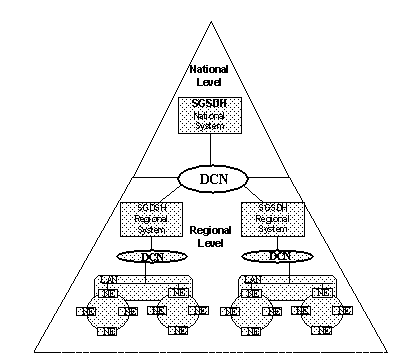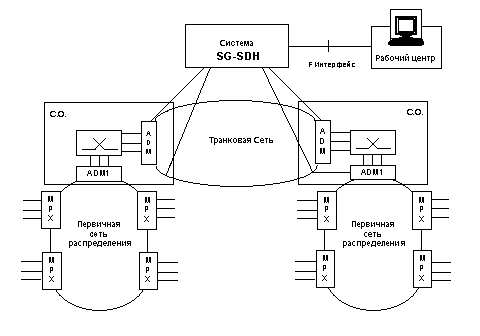 |
 |
 |
 |
 |
 |
 |
 |
 |
 |
SG-SDHNetwork Integrated Management SystemThe Synchronous Digital HierarchyThe International definition of the Synchronous Digital Hierarchy (SDH) has allowed to obtain a single transitive standard throughout the world, letting the technological innovation of network transmissive infrastructure begin in earnest. The new network technology allows an enhanced ability to manage network elements and the network itself, which translates for the telecommunication operator into: -Being able to offer a broader range of new services;-Automated, flexible transport services;-Increased transport service quality,-Reduced intervention times in case of failure;-Reduced operating costs.The main benefits provided by SDH, over the previous technology PDH (Plesiochronous Digital Hierarchy) can be summarized as follows: · Standard optical interfacesallow the network operator to work in a multi-vendor environment; · High bit rateframes with bit rates of 155 Mbit/s, 622 Mbit/s, and 2.4 Gbit/s have been standardized; · Immediate access to tributariesallows more efficiency in dropping-inserting tributary streams into the frames of the various hierarchical orders; · Transport of additional management informationusing the appropriate management channels provided for in the SDH frame.
Fig.1: System ArchitectureThe SDH transmissive technique thus originated with the goal of over coming the limitations of the PDH technology, due mostly to its insufficient network management capabilities. SDH therefore meets telecommunications operators' need to have a fiber optic network structure capable of supplementing the exceptional performance provided by this physical means with flexibility and manageability. The SystemThe SDH Network Integrated Management System (SG-SDH) has been developed by Telesoft S.p.A. specifically to support Telecommunications Operator activities, providing:
The SG-SDH system accomplishes the functions of the first two layers of the envisioned TMN architecture, i.e.: · Element Manager (EM) Layer,provides SDH equipment management functions, such as equipment and cross-connects configuration, alarms monitoring, testing and collecting quality data. · Network Manager (NM) Layer,provides network management functions such as "end to end path set-up", "path provisioning", network-wide alarms correlation, quality measurements for end to end connections. Element Managers communicate with the Network Manager through a Q3 interface. Thus devices with proprietary interfaces may be inserted in the network, requesting a Q3 interface to be provided on the Element Manager. System ArchitectureThe SG-SDH has a physical architecture based on a two-layer management network: · National LayerThe layer where the Management System operating as Network Manager (NM) for the whole SDH network resides; the NM is connected to each of the regionally distributed systems through an Extended LAN (DACON-L); · Regional LayerThe layer where the Regional Systems reside; each of them is connected, again through an Extended LAN, to all equipment included in its own administrative domain, performing Element Management (EM) functions. The system configuration can be made redundant through the use of multiple computers sharing the load. User InterfaceMan-machine interaction occurs through the User Interface(UI), which provides all the system functionalities and allows the operator to have total control over the equipment and the network under his/her competence. The interaction is managed through the use of graphic and/or numeric windows representing the various areas into which the network has been logically divided. The SG-SDH system, through a Client/Server architecture, provides the capability to distribute operator positions geographically, ensuring equipment management, operation and maintenance also by means of the TLC Operator decentralized organizational structures. Remote workstations, like local ones, allow access to the system's functionalities according to pre-configured operator profiles. 
Fig.2: Network ArchitectureFunctions· Network Management Functionalities: -Graphic network representation-Network Configuration-Management of the network hierarchical partitioning-"Layering G803 " layered network presentation;-Path provisioning;-Alarms and network events monitoring,-Quality measurements· Element Manager Functionalities: -Equipment device and configuration acquisition;-Configuration of electronic cross-connects on the matrix that configure the device device, -Configuration of the device's synchronism sources;-Remotely loading SW onto the device;-Monitoring alarms at device level.Managed DevicesNetwork devices managed by the SG-SDH system are shown in the following table:
Hardware and Software RequirementsThe SG-SDH system architecture requires the hardware and system software shown in the following table. The size of the system's hardware can be scaled according to the load induced by the controlled network.
|
 |
 |
 |
 |
 |
 |
|
E-mail: company@tlsoft.ru Contact information |
Copyright © 1996-1998 Telesoft Russia |
 _
_
